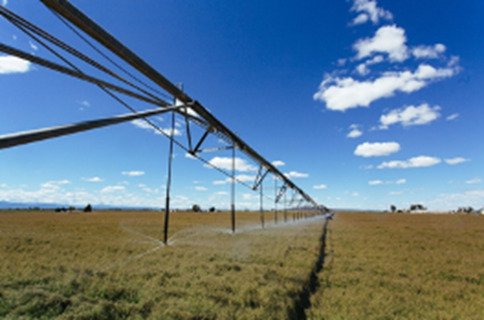Deschutes River Conservancy, COID seek to boost farms’ water efficiency

Goals: Reduce water delivery needs, restore river flow
BEND, Ore. (KTVZ) -- The Deschutes River Conservancy and Central Oregon Irrigation District announced plans Wednesday for a new on-farm program that will seek to increase on-farm irrigation efficiencies and conserve water.
At a time when Central Oregon’s water resources are being stretched further than ever -- and Wickiup Reservoir is almost completely dry, in unprecedented fashion -- improving on-farm efficiencies has great potential to conserve water in a way that is beneficial to all users and the region, the two organizations' announcement said.
Agriculture is the largest user of surface water in the Deschutes Basin, with irrigators using more than 86% of the water diverted from rivers and streams.
The goal of the on-farm program is to modernize delivery and irrigation systems, to reduce the amount of water needed to deliver and efficiently apply on COID farms. These projects will help meet the needs of the river and other irrigation water demands in the Deschutes Basin.
On-farm efficiency is defined as anything past the point of irrigation delivery – including private laterals and on-farm application methods.
The amount of water COID saves through on-farm improvements, piping, and other conservation measures can be shared with North Unit Irrigation District and other junior water right holders to ensure that farmers have the water they need, even in dry years.
NUID will then be able to make water available from their storage in Wickiup Reservoir, to increase winter flows in the Deschutes River.
“While we cannot create new water, losses from inefficient delivery systems can be reallocated,” said Shon Rae, COID’s deputy managing director.
COID has made an initial investment of $100,000 over two years to jump-start the program and added a full-time staff member dedicated to the On-Farm Program. In addition, COID will be launching a low-interest loan program to district irrigators for qualified projects.
Repeated low snowpack and scant annual precipitation, along with higher than average temperatures, have reduced natural flows in the river and resulted in record-low water storage levels in Central Oregon reservoirs.
There is not enough stored water to augment natural flows, a strategy that water managers have depended upon, given that demand otherwise exceeds natural river flows.
“Our first focus is to identify priorities, outreach needs, funding sources, and determine ways to measure and evaluate the program,” said Lisa Seales, who is serving as on-farm consultant. “Our next step is to develop a formal program structure and outreach plan.”
Rae added, “Voluntary efforts by landowners who undertake on-farm improvements combined with large scale piping projects will allow us to achieve system-wide results in less time.”
The program could focus on piping private laterals and irrigation conversions/upgrades to a more efficient system, as well as provide information and technical assistance for landowners to efficiently maintain and manage their systems.
This work can also create additional opportunities to accelerate water marketing programs with willing landowners.
“We’re amassing a list of potential funders that includes federal and state agency grants and loans, utility provider incentives, and a COID loan program to assist interested landowners in completing their desired on-farm project,” Seales said.
Program evaluation could involve measuring increased water and energy efficiency or crop yield, the number of acres or landowners served by the program, the number of miles of pipe installed, or even reductions in time and money spent on maintenance.
For the DRC, success will be measured by a reduction in demand that provides benefit to basin-wide water resources and rivers.
DRC Program Manager Natasha Bellis said, “We see on-farm efficiency work as one of the important tools in the toolbox to restore flows. When canal piping is paired with on-farm efficiency upgrades and water marketing programs, the benefits to the basin will be multiplied.”
# # #
About the Deschutes River Conservancy: Almost twenty-five years ago, the Deschutes River Conservancy (DRC) formed with a mission to restore streamflow and improve water quality in the Deschutes River Basin. The DRC specializes in programs and projects that employ voluntary, market-based incentives to restore flows. The DRC is non-litigious and serves as leaders and facilitators of basin-wide water management conversations. The board is composed of key private and public stakeholders in the basin. The organization has worked with eight irrigation districts and over 200 landowners to restore over 208 cubic feet per second of streamflow to the basin’s rivers and streams. www.deschutesriver.org
About Central Oregon Irrigation District: Established in 1918, Central Oregon Irrigation District “COID” is a Municipal Corporation of the State of Oregon. The District’s mission is to provide a reliable supply of water to 3,500 patrons throughout Bend, Redmond, Powell Butte, and Alfalfa. COID operates and maintains over 400 miles of canals that collectively deliver water to approximately 46,222 acres of productive land. www.coid.org
About Lisa Seales: Lisa Seales is a native Oregonian who has spent the last decade studying and working on water issues in the Deschutes Basin. With a PhD in Interdisciplinary Ecology from the University of Florida focusing on water resource management and policy in Oregon, and over twenty years worth of experience working as an educator, researcher, writer, and editor, Lisa is dedicated to helping find ways to more efficiently and sustainably manage natural resources. Lisa’s current and past work experience includes working for the Farmers Conservation Alliance; serving on the Board of Directors at The Environmental Center;